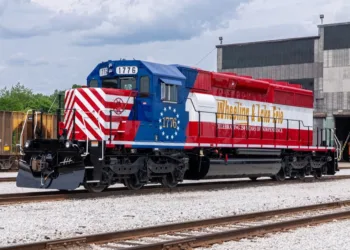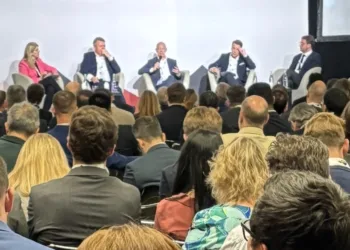The now-paused fees on Chinese ships docking at U.S. ports are a misguided attempt to revitalize U.S. maritime fortunes at the expense of American exporters, a transport trade group executive said.
“The U.S. Trade Representative fees on China-built and -owned ships did not last long enough, and the export freight volume was not large enough, for those fees to impact agricultural and other exporters,” said Peter Freidmann, executive director of the Agriculture Transportation Coalition, in an interview with FreightWaves. “However, the millions of dollars paid by two significant carriers of U.S ag exports – OOCL and Cosco – was concerning, as we do not like to see our carriers’ costs increase; during this period of low cargo volume and low rates, as is the case for any business, operating costs must be recovered.
“Eventually the customer, including ag exporters, will pay the bill.”
The fees assessed Chinese ships at $50 per net ton per voyage to the U.S. While other carriers shifted ships and tweaked services to minimize their exposure, published reports said Cosco of China and Hong Kong subsidiary OOCL paid approximately $42 million just in the first week after the fees went into effect Oct. 14. Analysts estimated that the China lines could be liable for as much as $1.5 billion in fees in 2026.
Beijing and Washington suspended the reciprocal fees for one year as part of a broad trade agreement following the late October meeting of President Donald Trump and Chinese leader Xi Jinping in South Korea.
“We are pleased these fees have been suspended for a year, and will work to assure they do not rear their ugly head again,” Friedmann said. “Making transport of U.S. exports more expensive than the transport of competing exports from other countries, which is what the USTR fees would have done, only make the U.S. farmers less competitive, without creating demand for U.S.-built cargo vessels.”
The fees followed an investigation by USTR that found China leveraged unfair trade practices to build a dominant position in shipping and shipbuilding. They aimed to blunt Beijing’s efforts while kickstarting a revival of American shipbuilding. The Trump administration early on granted an exemption for empty vessels arriving to load U.S. agricultural exports such as soybeans after complaints from farmers.
But exporters have another problem.
“People are worried about if and when China will resume buying soybeans in the volume they have in recent years,” Friedmann said. “And they are also cogniscent of the dramatic increases in the volume of soybeans that are being produced in Brazil.”
Trump’s tariffs led China to temporarily shun the U.S. in favor of Brazil suppliers. China this year has imported 42 million tons of soybeans from Brazil compared with 16.57 million tons from January-July from the U.S. As part of the October trade pact Beijing pledged to buy 12 million metric tons of U.S. soybeans in November and December but has committed to orders totaling just 840,000 tons in December and January.
“If Congress and President Trump intend U.S. shipyard modernization, the SHIPS Act, while costly, is an approach with bipartisan sponsorship that will fund workforce training and shipyard revitalization, so we can learn how to build competitive ships,” said Friedmann.
To date, South Korean conglomerate Hanwha has committed $5 billion to expand its Philadelphia shipyard: CMA CGM of France plan to invest $20 billion in U.S. maritime development but has yet to offer details. Swiss-based Mediterranean Shipping Co. has re-registered a single container ship under the U.S. flag.
Find more articles by Stuart Chirls here.
Related coverage:
Fewer empties, steady trade: Oakland port’s volume shift
CMA CGM profit collapses on ocean ‘slowdown’
Looted barge returns: Brooklyn Bridge’s unexpected journey
Trucking exodus: A new threat to US ocean logistics
The post ‘Ugly’ fees On Chinese ships concern US ag exporters appeared first on FreightWaves.






















